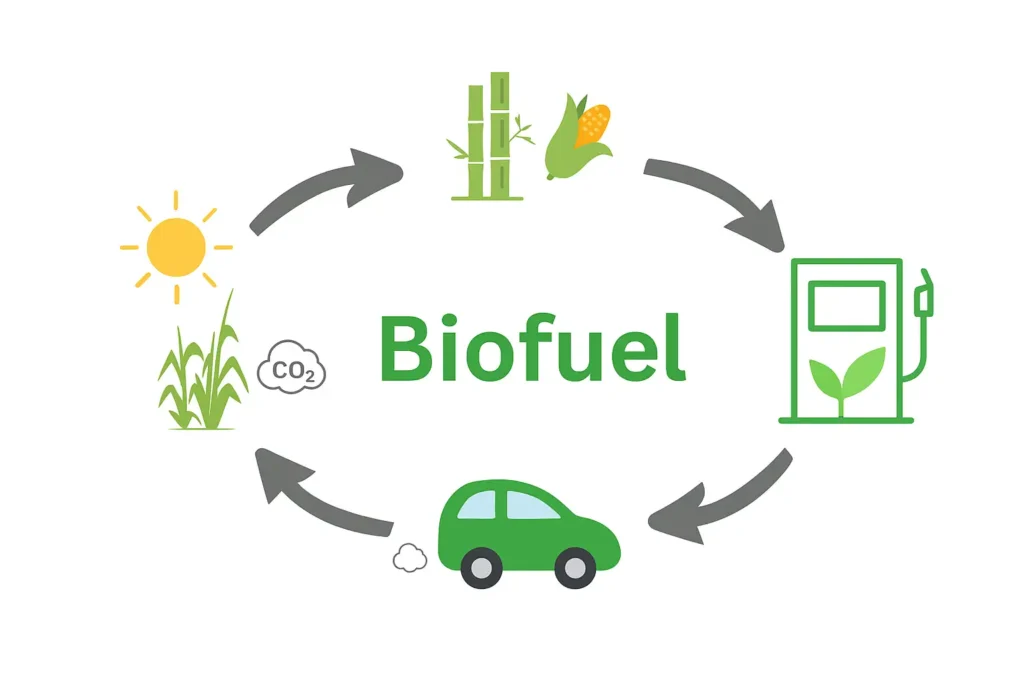India stands at a pivotal moment in its energy journey. Through its bold policy moves and determined innovation, India is rewriting its future by embracing ethanol blending. Moreover, this bold step not only creates significant sustainability benefits but also strengthens rural livelihoods, enhances energy security, and helps combat climate change. Ethanol blending for sustainable India” is no longer just a digital prompt now, but it captures the nation’s transition towards a green tomorrow.
India’s Ethanol-Blending Success: A Snapshot
As of 2024, ethanol blending has already reached 15%, up from the earlier target of 10% by 2022. The country now aims for 20% blending (E20) by 2025, with more E20-compatible vehicles and ethanol-exclusive fuel pumps being rolled out. Public Sector Oil Marketing Companies (OMCs) have established E20 fuel availability at over 13,500 outlets . So , it’s a clear sign of commitment and progress.
This transformation is not an unnoticed part now . Ethanol blending has now :
- Saved ₹1.1 trillion in foreign exchange
- Prevented 50 million tonnes of CO₂ emissions
- Also, Substituted 181 lakh metric tonnes of crude oil

Why Ethanol Blending Matters for Sustainable India
1. Energy Security and Reduced Imports
As of today , India imports over 87% of its crude oil, which strains its economy and exposes it to global price shocks. Ethanol blending allows India to replace imported petrol in place of domestic biofuels, which promotes self -reliance . Moreover, this shift has already saved massive foreign exchange and safeguarded energy interests.
2. Cleaner Air and Reduced Carbon Emissions
Ethanol contains oxygen molecules that allow the fuel to burn completely. As a result, carbon monoxide, particulate matter, and other harmful emissions drop significantly. The National Bio-Energy Mission supports this cleaner alternative, directly contributing to India’s Net-Zero 2070 goal. So far, over 544 lakh metric tonnes of CO₂ emissions have been avoided.
3. Rural Prosperity and Employment
Ethanol production has also come out with new income streams to farmers. Crops like sugarcane and maize, along with agricultural waste, have become valuable biofuel sources. The program has distributed ₹87,558 crore to farmers and ₹1,45,930 crore to distillers, increasing rural economic growth and reducing migration from villages.
4. Sustainable Agriculture and Waste Utilisation
The ethanol push has prompted diversification from water-intensive crops. With the government’s support, farmers now grow maize and sorghum for ethanol. Surplus grains like FCI rice are also being diverted to ethanol production, fetching ₹51.55/litre for maize and ₹56.87/litre for FCI rice. Hence, these prices make ethanol production both viable and beneficial for farmers.
5. Investment and Global Leadership
India’s ethanol story has drawn significant investment over ₹40,000 crore in new biofuel infrastructure. The launch of the Global Biofuels Alliance (GBA) at the G20 Summit positioned India as a leader in biofuels trade and technology. With a Long-Term Ethanol Procurement Policy in place, the sector promises revenue stability and growth.
Major Challenges in India’s Ethanol Journey
Despite all the visible progress, ethanol blending still faces multiple hurdles and challenges:
1. Water-Intensive Production
Sugarcane-based ethanol consumes vast amounts of water. States like Maharashtra and Uttar Pradesh already face water stress, and sugarcane adds to the burden. According to NITI Aayog, sugarcane and paddy together consume 70% of the country’s irrigation water , which results in shifting towards water-efficient feedstocks.
2. Food Security Concerns
Diverting food grains to ethanol raises the risk of inflation and reduced food availability, especially during shortages. Hence , Global institutions have warned that rising biofuel demand can pressure food supply chains and affect vulnerable populations.
3. Production Bottlenecks and Logistics
Several states still lack ethanol production capacity. Supply chain inefficiencies and inadequate storage facilities have hampered uniform ethanol availability. Many regions rely on ethanol imports from other states which raises the costs and also causes delays.
4. Vehicle Compatibility Issues
India’s existing vehicle fleet runs on E10 fuel. Transitioning to E20 requires engine modifications to avoid corrosion, reduced fuel economy, and engine wear. Although, automakers are designing E20-compliant models, retrofitting older vehicles remains a challenge.
5. Price Instability
Ethanol prices fluctuate with raw material output. Distillers depend on government-fixed prices that may not align with market dynamics. Ethanol also provides less mileage than petrol, potentially increasing fuel expenses for consumers.
6. Environmental and Wastewater Issues
While ethanol cuts tailpipe emissions, its production process can damage the environment if not managed properly. Distilleries produce wastewater known as vinasse, which requires treatment before disposal. If left untreated, it pollutes aquatic systems and harms the biodiversity.
7. Heavy Reliance on Subsidies
Government incentives keep the ethanol ecosystem alive. However, the entire supply chain remains highly dependent on subsidies, tax breaks, and interest subvention schemes. A sudden reverse in policy could collapse investments and production efforts.
The Way Forward: Strengthening Ethanol for a Greener Tomorrow
A. Widen Feedstock Base
Firstly , India must shift away from sugarcane dependence. It should emphasize more in encouraging maize, sorghum, and agricultural waste for ethanol production, which can ensure sustainability. Also , strengthening the PM-JI-VAN Yojana and offering better R&D support can unlock second-generation ethanol potential.
B. Empower Rural Distilleries
Secondly , decentralised ethanol units linked to Farmer Producer Organisations (FPOs) can cut transport costs and create local jobs. Bio-refinery clusters in grain-surplus states can balance regional supply.
C. Upgrade Vehicle and Fuel Infrastructure
Third , Mandatory E20 vehicle manufacturing, supported by retrofitting policies and public awareness, will ease the transition. More ethanol fuel stations, especially outside sugar belt states, will improve accessibility.
D. Stabilise Pricing and Encourage Investment
Moreover, establishing a price stabilization fund and also introduction of a carbon credit system can shield producers from market volatility. Promoting market-linked procurement and dynamic pricing models will draw in private capital.
E. Protect Water Resources
Incentives under the PM Krishi Sinchayee Yojana and the adoption of drip irrigation for ethanol crops can reduce water consumption. Also , mandating zero-liquid discharge (ZLD) systems will limit wastewater pollution.
F. Improve Governance and Coordination
Lastly , a unified single-window clearance system for ethanol plants, stronger interstate transport norms, and ethanol-specific state industrial policies can remove bottlenecks and attract large-scale investments.
Conclusion
India’s ethanol-blending program stands as a beacon of hope in the global clean energy movement. It has saved billions in foreign exchange, cut down emissions, and empowered rural India. But to meet the 20% ethanol blending target by 2025, the country must now act in a faster and smarter way . By expanding feedstock sources, improving infrastructure, and sustaining policy momentum, India can secure a cleaner, greener, and more self-reliant future. Ethanol blending is not just a fuel strategy, it’s a national mission.
Frequently Asked Questions (FAQs)
A: Ethanol blending means mixing plant‑based ethanol with petrol to reduce reliance on fossil fuels. It supports cleaner air, improves energy security, and strengthens rural economies, making it vital for India’s sustainable development.
A: Since 2014, ethanol blending has prevented over 50 million tonnes of CO₂ emissions, offering a major environmental benefit and helping India move toward its Net‑Zero 2070 goal.
A: India exceeded its initial 10% blending goal by 2022 and hit 15% by 2024. The government now targets 20% blending (E20) by 2025, backed by expanding fuel stations and the development of E20‑compatible vehicles.
A: The program faces several hurdles, such as dependence on water‑intensive crops, risks to food security, limited infrastructure, vehicle engine compatibility concerns, price volatility, environmental waste from production, and heavy reliance on government subsidies.
A: India can accelerate progress by diversifying feedstocks beyond sugarcane, promoting rural distilleries, expanding E20 fuel infrastructure, offering stable procurement policies, ensuring sustainable water usage, and improving policy coordination across states.
CITATIONS
- Government measures to increase Ethanol Blending beyond 20%
- Food vs fuel: Surge in ethanol blending and its impact on sugar prices
- Government likely to increase ethanol blending in petrol to 27%
Prelims Question (MCQ)
Q. With reference to the Ethanol Blending Programme (EBP) in India, consider the following statements:
- Ethanol used in blending is primarily derived from coal-based bioethanol units.
- The E20 target aims to achieve 20% ethanol blending with petrol by 2025.
- Ethanol blending helps in reducing greenhouse gas emissions.
Which of the statements given above is/are correct?
A) 1 and 2 only
B) 2 and 3 only
C) 1 and 3 only
D) 1, 2, and 3
Mains Question
Q. Ethanol blending is being projected as a key pillar of India’s clean energy and rural economy strategy. Examine the progress, challenges, and the way forward for India’s Ethanol Blending Programme in achieving sustainable development goals.
(250 words)












